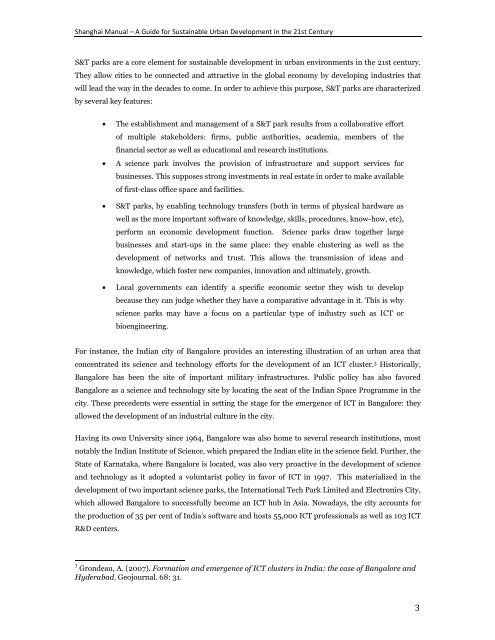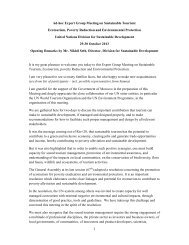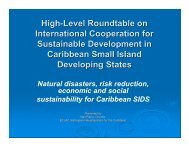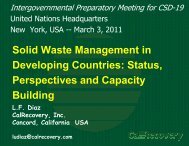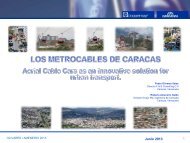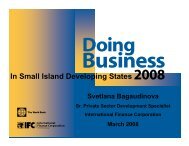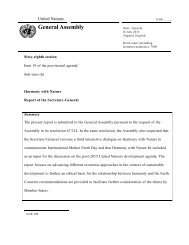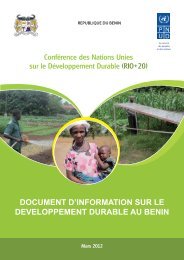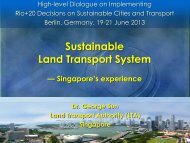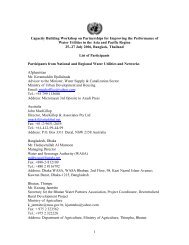A Guide for Sustainable Urban Development of the 21st Century
A Guide for Sustainable Urban Development of the 21st Century
A Guide for Sustainable Urban Development of the 21st Century
You also want an ePaper? Increase the reach of your titles
YUMPU automatically turns print PDFs into web optimized ePapers that Google loves.
Shanghai Manual – A <strong>Guide</strong> <strong>for</strong> <strong>Sustainable</strong> <strong>Urban</strong> <strong>Development</strong> in <strong>the</strong> <strong>21st</strong> <strong>Century</strong>S&T parks are a core element <strong>for</strong> sustainable development in urban environments in <strong>the</strong> <strong>21st</strong> century.They allow cities to be connected and attractive in <strong>the</strong> global economy by developing industries thatwill lead <strong>the</strong> way in <strong>the</strong> decades to come. In order to achieve this purpose, S&T parks are characterizedby several key features:• The establishment and management <strong>of</strong> a S&T park results from a collaborative ef<strong>for</strong>t<strong>of</strong> multiple stakeholders: firms, public authorities, academia, members <strong>of</strong> <strong>the</strong>financial sector as well as educational and research institutions.• A science park involves <strong>the</strong> provision <strong>of</strong> infrastructure and support services <strong>for</strong>businesses. This supposes strong investments in real estate in order to make available<strong>of</strong> first-class <strong>of</strong>fice space and facilities.• S&T parks, by enabling technology transfers (both in terms <strong>of</strong> physical hardware aswell as <strong>the</strong> more important s<strong>of</strong>tware <strong>of</strong> knowledge, skills, procedures, know-how, etc),per<strong>for</strong>m an economic development function. Science parks draw toge<strong>the</strong>r largebusinesses and start-ups in <strong>the</strong> same place: <strong>the</strong>y enable clustering as well as <strong>the</strong>development <strong>of</strong> networks and trust. This allows <strong>the</strong> transmission <strong>of</strong> ideas andknowledge, which foster new companies, innovation and ultimately, growth.• Local governments can identify a specific economic sector <strong>the</strong>y wish to developbecause <strong>the</strong>y can judge whe<strong>the</strong>r <strong>the</strong>y have a comparative advantage in it. This is whyscience parks may have a focus on a particular type <strong>of</strong> industry such as ICT orbioengineering.For instance, <strong>the</strong> Indian city <strong>of</strong> Bangalore provides an interesting illustration <strong>of</strong> an urban area thatconcentrated its science and technology ef<strong>for</strong>ts <strong>for</strong> <strong>the</strong> development <strong>of</strong> an ICT cluster. 3 Historically,Bangalore has been <strong>the</strong> site <strong>of</strong> important military infrastructures. Public policy has also favoredBangalore as a science and technology site by locating <strong>the</strong> seat <strong>of</strong> <strong>the</strong> Indian Space Programme in <strong>the</strong>city. These precedents were essential in setting <strong>the</strong> stage <strong>for</strong> <strong>the</strong> emergence <strong>of</strong> ICT in Bangalore: <strong>the</strong>yallowed <strong>the</strong> development <strong>of</strong> an industrial culture in <strong>the</strong> city.Having its own University since 1964, Bangalore was also home to several research institutions, mostnotably <strong>the</strong> Indian Institute <strong>of</strong> Science, which prepared <strong>the</strong> Indian elite in <strong>the</strong> science field. Fur<strong>the</strong>r, <strong>the</strong>State <strong>of</strong> Karnataka, where Bangalore is located, was also very proactive in <strong>the</strong> development <strong>of</strong> scienceand technology as it adopted a voluntarist policy in favor <strong>of</strong> ICT in 1997. This materialized in <strong>the</strong>development <strong>of</strong> two important science parks, <strong>the</strong> International Tech Park Limited and Electronics City,which allowed Bangalore to successfully become an ICT hub in Asia. Nowadays, <strong>the</strong> city accounts <strong>for</strong><strong>the</strong> production <strong>of</strong> 35 per cent <strong>of</strong> India’s s<strong>of</strong>tware and hosts 55,000 ICT pr<strong>of</strong>essionals as well as 103 ICTR&D centers.3 Grondeau, A. (2007). Formation and emergence <strong>of</strong> ICT clusters in India: <strong>the</strong> case <strong>of</strong> Bangalore andHyderabad. Geojournal. 68: 31.3


